Related Research Articles
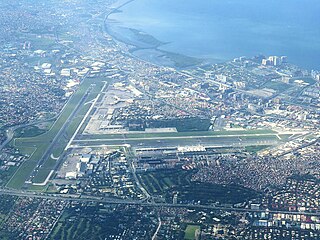
Ninoy Aquino International Airport, also known as Manila International Airport (MIA), is the main international airport serving Metro Manila in the Philippines. Located between the cities of Pasay and Parañaque, about 7 kilometers (4.3 mi) south of Manila proper and southwest of Makati, it is the main gateway for travelers to the Philippines and serves as a hub for PAL Express and Philippine Airlines. It is also the main operating base for AirSWIFT, Cebgo, Cebu Pacific, and Philippines AirAsia.

Taguig, officially the City of Taguig, is the fifth-most populous city in the Philippines situated in eastern shores of Metro Manila, the national capital region. It is a center for culture, finance, technology, entertainment and media, academics, and the arts and fashion. The city hosts several embassies, making it an important center for the country's international diplomacy. As the home of Bonifacio Global City, major multinational corporations have their headquarters in the city, and it has the fourth largest skyline in the Philippines, with 289 high-rises, 80 of which exceed 100 m (328 ft).

The South Luzon Expressway (SLEX), signed as E2 of the Philippine expressway network and R-3 of the Metro Manila arterial road network, is a controlled-access highway that connects Metro Manila to the provinces in the Calabarzon, Mimaropa and Bicol Region on the island of Luzon in the Philippines. The expressway has a length of 49.56 km, traveling from its northern terminus at the Magallanes Interchange in Makati to its southern terminus at Santo Tomas, Batangas, connecting it to the Southern Tagalog Arterial Road. A portion of the expressway from the Magallanes Interchange to the Calamba Exit is part of Asian Highway 26 of the Asian highway network. It will be the longest expressway in the Philippines starting with the completion of Toll Road 4 surpassing the Subic–Clark–Tarlac Expressway (SCTEX) as well as providing a gateway to Visayas upon the completion of Toll Road 5.

The Metro Rail Transit Line 3, also known as the MRT Line 3, MRT-3, or Metrostar Express, is a rapid transit line in Metro Manila in the Philippines. The line runs in an orbital north to south route following the alignment of Epifanio de los Santos Avenue (EDSA). Despite its name, the line is more akin to a light rapid transit system owing to its tram-like rolling stock while having total grade separation and high passenger throughput. The line is officially known as the Yellow Line. Its current General Manager is Oscar Bongon.
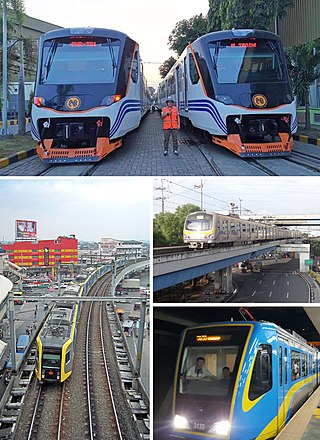
Rail transportation in the Philippines is currently used mostly to transport passengers within Metro Manila and provinces of Laguna and Quezon, as well as a commuter service in the Bicol Region. Freight transport services once operated in the country, but these services were halted. However, there are plans to restore old freight services and build new lines. From a peak of 1,100 kilometers (680 mi), the country currently has a railway footprint of 533.14 kilometers (331.28 mi), of which only 129.85 kilometers (80.69 mi) are operational as of 2025, including all the urban rail lines. World War II, natural calamities, underspending, and neglect have all contributed to the decline of the Philippine railway network. In the 2019 Global Competitiveness Report, the Philippines has the lowest efficiency score among other Asian countries in terms of efficiency of train services, receiving a score of 2.4, and ranking 86th out of 101 countries globally. The government is currently expanding the railway network up to 1,900 kilometers (1,200 mi) by 2022 through numerous projects.

The Metro Manila Skyway, officially the Metro Manila Skyway System (MMSS) or simply the Skyway, is an elevated highway serving as the main expressway of Metro Manila, Philippines. It connects the North and South Luzon Expressways with access to Ninoy Aquino International Airport via the NAIA Expressway (NAIAX). It is the first fully grade-separated highway in the Philippines and one of the longest elevated highways in the world, with a total length of approximately 39.2 kilometers (24.4 mi).

The North Triangle Common Station, officially designated as the Unified Grand Central Station and North EDSA for the MRT Line 7, commonly known as the Common Station or North Triangle station, is an under-construction rapid transit terminal and transport hub that will connect LRT Line 1, MRT Line 3, and MRT Line 7, and the nearby Metro Manila Subway. It is located in Bagong Pag-asa, Quezon City, Philippines, and is named after its location, which is at the corner of EDSA and North Avenue.
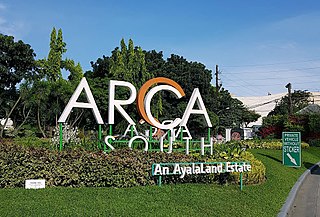
Arca South is a 74-hectare (180-acre) mixed-use estate owned by Ayala Land, Inc. located at East Service Road, Barangay Western Bicutan, Taguig.

FTI station is a railway station located on the South Main Line in Taguig, Metro Manila, Philippines. It is named after its major landmark, the grounds of the formerly state-owned Food Terminal, Inc. which is now renamed as Arca South.
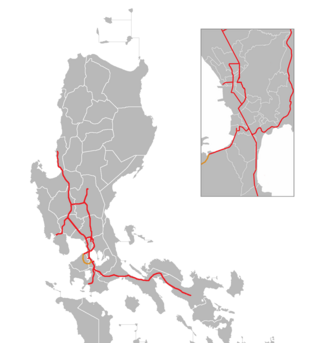
The Cavite–Laguna Expressway, signed as E3 of the Philippine expressway network, is a partially operational controlled-access toll expressway in the provinces of Cavite and Laguna, Philippines. The construction of the 44.63-kilometer-long (27.73 mi) expressway, which began in June 2017, costs an estimated ₱35.43 billion. Once completed, it will connect the Manila–Cavite Expressway in Kawit to the South Luzon Expressway in Biñan and is expected to ease the traffic congestion in the Cavite–Laguna area, particularly along the Aguinaldo Highway, Governor's Drive, and the Santa Rosa–Tagaytay Road.

The Metro Manila Subway, formerly known as the Mega Manila Subway (MMS) is an under-construction underground rapid transit line in Metro Manila, Philippines. The 33-kilometer (21 mi) line, which will run north–south between Valenzuela, Quezon City, Pasig, Taguig, Parañaque and Pasay, consists of 17 stations between the East Valenzuela and Bicutan stations. It will become the country's second direct airport rail link after the North–South Commuter Railway, with a branch line to Ninoy Aquino International Airport.

Mactan–Cebu International Airport (MCIA) is the main international airport serving Metro Cebu; it serves as the main gateway to the Central Visayas region in the Philippines. Located on a 797-hectare (1,970-acre) site in Lapu-Lapu City on Mactan, it is the second busiest airport in the Philippines. Opened on April 27, 1966, the airport serves as a hub for Philippine Airlines, and as an operating base for Cebu Pacific, Philippines AirAsia, and Sunlight Air.

The Metro Rail Transit Line 7, also known as MRT Line 7 or MRT-7, is a rapid transit line under construction in the Philippines. When completed, the line will be 22.8 kilometers (14.2 mi) long, with 14 stations, and the first line to have a third rail electrification. The line runs in a northeast–southwest direction, beginning at San Jose del Monte, Bulacan up to the North Triangle Common Station in North Avenue, Quezon City. It will be the second line to use heavy metro cars after LRT Line 2, which was inaugurated in 2003.
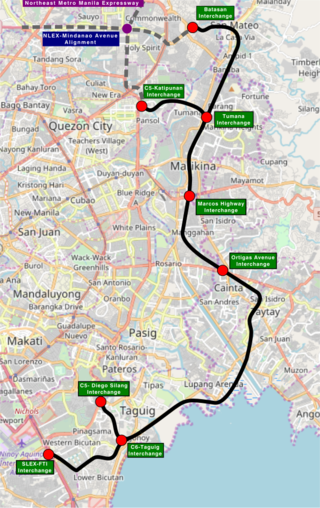
The Southeast Metro Manila Expressway (SEMME), also known as Skyway Stage 4, C-6 Expressway and formerly Metro Manila Expressway, is a proposed 32.664-kilometer (20.296 mi) tolled expressway running across eastern Metro Manila and western Rizal. The expressway will help decongest the existing roadways across Metro Manila, such as EDSA and Circumferential Road 5. The expressway is part of the larger Circumferential Road 6 project, expanding from the original C-6 currently passing from General Santos Avenue in Taguig up to Highway 2000 in Taytay, will expand to Cainta, Pasig, Marikina, San Mateo, and in Quezon City.
SkyTrain is a proposed automated people mover line meant to serve the city of Makati and Bonifacio Global City area in Taguig, Metro Manila. Originally scheduled for completion in 2021, as of March 2022, construction has yet to begin.

The Parañaque Integrated Terminal Exchange is a public transport terminal in Parañaque, Metro Manila, Philippines. PITX is built and operated by Megawide Construction Corporation and the Department of Transportation (DOTr) under the Philippine government's Public-Private Partnership program.
The Makati Intra-city Subway (MkTr) was a planned underground rapid transit line to be located in Makati, Metro Manila, that will link establishments across the city's business district. The construction of it was planned through a public-private partnership program between the Makati City Government and a private consortium headed by Philippine Infradev Holdings. Proponents of the subway are expected to begin construction by December 2018, and Makati Mayor Abigail Binay projects completion by 2025. The subway will cost $1.8 billion and is expected to accommodate 500,000 passengers daily. It will also have seven stations, with connections to the existing MRT Line 3 and Pasig River Ferry Service.

New Manila International Airport, also known as Bulacan International Airport, is an international airport under construction on the coastal areas of Bulakan, Bulacan, 35 km (22 mi) north of Manila, the capital of the Philippines. The project was proposed by the San Miguel Corporation (SMC) and is set to help decongest Ninoy Aquino International Airport (NAIA), the main gateway to the capital for air travelers.

The North–South Commuter Railway, also known as the Clark–Calamba Railway, is a 147-kilometer (91-mile) commuter rail system under construction on the island of Luzon in the Philippines. Running from New Clark City in Capas, Tarlac, to Calamba, Laguna, with 36 stations and four services, the railway is designed to improve connectivity within the Greater Manila Area and will be integrated with the railway network in the region.

The EDSA Carousel, also known as Route 1 and formerly and still referred to as Route E, is a bus rapid transit (BRT) system, part of several bus routes in Metro Manila. It is situated along EDSA and other roads, running on a dedicated right-of-way called the EDSA Busway, separated from normal road traffic in most of its stretch by concrete barriers and steel bollards on the innermost lane.
References
- 1 2 3 Dela Paz, Chrisee (January 26, 2016). "Ayala to start building ITS-South terminal by September". Rappler.com. Rappler. Archived from the original on January 18, 2018. Retrieved January 18, 2018.
- 1 2 3 Yee, Jovie. "Taguig transport terminal breaks ground". Philippine Daily Inquirer . Archived from the original on March 9, 2024. Retrieved January 17, 2018.
- ↑ Pateña, Aerol John (December 16, 2018). "DOTr pursues various transpo projects to tackle PH traffic woes". Philippine News Agency. Archived from the original on July 9, 2023. Retrieved July 9, 2023.
- 1 2 "South Integrated Transport System (ITS) Project (Taguig Integrated Terminal Exchange) | PPP Center". ppp.gov.ph. Archived from the original on January 4, 2022. Retrieved January 4, 2022.
- ↑ "5 firms eye P4B ITS-South Terminal project". Rappler.com. Rappler. August 30, 2014. Archived from the original on January 18, 2018. Retrieved January 18, 2018.
- ↑ Manabat, Johnson (November 14, 2024). "DOTr eyes December groundbreaking for Taguig integrated terminal". ABS-CBN News. Retrieved February 2, 2025.
- ↑ "Heavy traffic expected in Bicutan, Taguig on Monday, Feb.3". GMA News Online. February 2, 2025. Retrieved February 2, 2025.
- ↑ Manahan, Jervis (February 3, 2025). "DOTr, AyalaLand break ground for construction of mega transport hub TCITX". ABS-CBN News . Retrieved February 3, 2025.
{{cite news}}: CS1 maint: url-status (link)